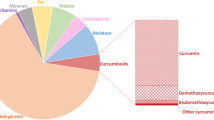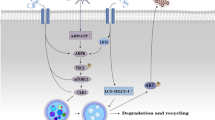Abstract
Palmitic acid (PA), a widely consumed saturated fat, is known to induce the apoptosis of vascular endothelial cells. This study examined the protective effect of anthocyanin from red radish (ARR), which has been shown to protect the cardiovascular system and is rich in polyacylated pelargonidin (P) glycosides, on PA-treated SV 40 transfected aortic rat endothelial cells (SVAREC). In all, 22 distinct anthocyanins were identified in the ARR via ultra-high-performance liquid chromatography-triple quadrupole mass spectrometry, the most abundant of which were pelargonidin-3-(p-coumaroyl)diglucoside-5-glucoside (31.60%), pelargonidin-3-(feruloyl)diglucoside-5-(malonyl)glucoside (22.98%), pelargonidin-3-(p-coumaroyl)diglucoside-5-(malonyl)glucoside (8.02%), and pelargonidin-3-(feruloyl)diglucoside-5-glucoside (6.25%). P displayed the highest serum level (93.72%) in the ARR-treated mice, while polyacylated P glucosides were also absorbed intact. Furthermore, ARR treatment effectively increased cellular activity and reduced the ratio of Bcl-2-associated X protein : B cell lymphoma-2, while simultaneously alleviating the excessive production of reactive oxygen species in PA-treated SVAREC. Transcriptome and further verification analyses confirmed that the ARR-inhibiting PA-induced apoptosis of SVAREC was related to the p38 mitogen-activated protein kinase signaling pathway. Our results are the first to demonstrate that ARR may be a promising phytochemical in the prevention of PA-induced endothelial dysfunction.





Similar content being viewed by others
Data availability statements
All data generated or analyzed during this study are included in this published article (and its supplementary information files).
Abbreviations
- ARR:
-
anthocyanins from red radish
- Bcl-2:
-
B cell lymphoma-2
- Bax:
-
Bcl-2-associated X protein
- C3G:
-
cyanidin-3-glucoside
- CVD:
-
cardiovascular disease
- JNK:
-
c-Jun NH2 terminal
- DCFH-DA:
-
dichlorofluorescein diacetate
- ERK:
-
extracellular signal-regulated kinase
- GO:
-
gene ontology
- KEGG:
-
Kyoto Encyclopedia of Genes and Genome
- MAPK:
-
mitogen-activated protein kinase
- MKK3:
-
mitogen-activated protein kinase kinase-3
- Mv:
-
malvidin
- Mv3G:
-
malvidin-3-glucoside
- PA:
-
palmitic acid
- P3G:
-
peonidin-3-glucoside
- P3PD5G:
-
pelargonidin-3-(p-coumaroyl)diglucoside-5-glucoside
- P3FD5MG:
-
pelargonidin-3-(feruloyl)diglucoside-5-(malonyl)glucoside
- P3PD5MG:
-
pelargonidin-3-(p-coumaroyl)diglucoside-5-(malonyl)glucoside
- P3FD5G:
-
pelargonidin-3-(feruloyl)diglucoside-5-glucoside
- P:
-
pelargonidin
- P3D5G:
-
pelargonidin-3-diglucoside-5-glucoside
- ROS:
-
reactive oxygen species
- SD:
-
standard deviation
- SVAREC:
-
SV 40 transfected aortic rat endothelial cells
- TNF-α:
-
tumor necrosis factor-α
- UHPLC-QqQ-MS/MS:
-
ultra-high-performance liquid chromatography-triple quadrupole mass spectrometry
References
Chareonrungrueangchai K, Wongkawinwoot K, Anothaisintawee T, Reutrakul S (2020) Dietary factors and risks of cardiovascular diseases: an umbrella review. Nutrients 12:1088. https://doi.org/10.3390/nu12041088
van Rooijen MA, Mensink RP (2020) Palmitic acid versus stearic acid: effects of interesterification and intakes on cardiometabolic risk markers-a systematic review. Nutrients 12:615. https://doi.org/10.3390/nu12030615
Zhao Q, Yang H, Liu F, Luo J, Zhao Q, Li X, Yang Y (2019) Naringenin exerts cardiovascular protective effect in a palmitate-induced human umbilical vein endothelial cell injury model via autophagy flux improvement. Mol Nutr Food Res 63:1900601. https://doi.org/10.1002/mnfr.201900601
Chen JH, Lee MS, Wang CP, Hsu CC, Lin HH (2017) Autophagic effects of Hibiscus sabdariffa leaf polyphenols and epicatechin gallate (ECG) against oxidized LDL-induced injury of human endothelial cells. Eur J Nutr 56:1963–1981. https://doi.org/10.1007/s00394-016-1239-4
Ockermann P, Headley L, Lizio R, Hansmann J (2021) A review of the properties of anthocyanins and their influence on factors affecting cardiometabolic and cognitive health. Nutrients 12:2831. https://doi.org/10.3390/nu13082831
**a M, Ling W, Zhu H, Ma J, Wang Q, Hou M, Tang Z, Guo H, Liu C, Ye Q (2009) Anthocyanin attenuates CD40-mediated endothelial cell activation and apoptosis by inhibiting CD40-induced MAPK activation. Atherosclerosis 202:41–47. https://doi.org/10.1016/j.atherosclerosis.2008.04.005
Tomisawa T, Nanashima N, Kitajima M, Mikami K, Takamagi S, Maeda H, Horie K, Lai FC, Osanai T (2019) Effects of blackcurrant anthocyanin on endothelial function and peripheral temperature in young smokers. Molecules 24:4295. https://doi.org/10.3390/molecules24234295
do Rosario VA, Chang C, Spencer J, Alahakone T, Roodenrys S, Francois M, Weston-Green K, Hölzel N, Nichols DS, Kent K, Williams D, Wright I, Charlton K (2021) Anthocyanins attenuate vascular and inflammatory responses to a high fat high energy meal challenge in overweight older adults: a cross-over, randomized, double-blind clinical trial. Clin Nutr 40:879–889. https://doi.org/10.1016/j.clnu.2020.09.041
Hollands WJ, Armah CN, Doleman JF, Perez-Moral N, Winterbone MS, Kroon PA (2018) 4-Week consumption of anthocyanin-rich blood orange juice does not affect LDL-cholesterol or other biomarkers of CVD risk and glycaemia compared with standard orange juice: a randomised controlled trial. Brit J Nutr 119:415–421. https://doi.org/10.1017/S0007114517003865
Xu JW, Ikeda K, Yamori Y (2007) Inhibitory effect of polyphenol cyanidin on TNF-alpha-induced apoptosis through multiple signaling pathways in endothelial cells. Atherosclerosis 193(2):299–308. https://doi.org/10.1016/j.atherosclerosis.2006.09.006
**a M, Wang M, Tashiro SI, Onodera S, Minami M, Ikejima T (2005) Dracorhodin perchlorate induces a375-s2 cell apoptosis via accumulation of p53 and activation of caspases. Biol Pharm Bull 28:226–232. https://doi.org/10.1248/bpb.28.226
Li W, Pang X, **ement jet drying. LWT - Food Sci Technol 127:109390. https://doi.org/10.1016/j.lwt.2020.109390
**g P, Zhao SJ, Ruan SY, **e ZH, Dong Y, Yu L (2012) Anthocyanin and glucosinolate occurrences in the roots of Chinese red radish (Raphanus sativus L.), and their stability to heat and pH. Food Chem 133:1569–1576. https://doi.org/10.1016/j.foodchem.2012.02.051
Park NI, Xu H, Li X, Jang IH, Park S, Ahn GH, Lim YP, Kim SJ, Park SU (2011) Anthocyanin accumulation and expression of anthocyanin biosynthetic genes in radish (Raphanus sativus). J Agric Food Chem 59:6034–6039. https://doi.org/10.1021/jf200824c
Park CH, Baskar TB, Park SY, Kim SJ, Valan Arasu M, Al-Dhabi NA, Kim JK, Park SU (2016) Metabolic profiling and antioxidant assay of metabolites from three radish cultivars. Molecules 21:157. https://doi.org/10.3390/molecules21020157
Li W, Gu M, Gong P, Wang J, Hu Y, Hu Y, Tan X, Wei J, Yang H (2021) Glycosides changed the stability and antioxidant activity of pelargonidin. LWT - Food Sci Technol 147:111581. https://doi.org/10.1016/j.lwt.2021.111581
Braga ARC, Murador DC, de Souza Mesquita LM, de Rosso VV (2018) Bioavailability of anthocyanins: gaps in knowledge, challenges and future research. J Food Compos Anal 68:31–40. https://doi.org/10.1016/j.jfca.2017.07.031
Xu Y, Li Y, **e J, **e L, Mo J, Chen W (2021) Bioavailability, absorption, and metabolism of pelargonidin-based anthocyanins using sprague-dawley rats and caco-2 cell monolayers. J Agric Food Chem 69:7841–7850. https://doi.org/10.1021/acs.jafc.1c00257
McGhie T, Walton MC (2007) The bioavailability and absorption of anthocyanins: towards a better understanding. Mol Nutr Food Res 51:702–713. https://doi.org/10.1002/mnfr.200700092
Kay CD (2006) Aspects of anthocyanin absorption, metabolism and pharmacokinetics in humans. Nutr Res Rev 19:137–146. https://doi.org/10.1079/NRR2005116
Na L, Chu X, Jiang S, Li C, Li G, He Y, Liu Y, Li Y, Sun C (2016) Vinegar decreases blood pressure by down–regulating AT1R expression via the AMPK/PGC–1α/PPARγ pathway in spontaneously hypertensive rats. Eur J Nutr 55:1245–1253. https://doi.org/10.1007/s00394-015-0937-7
Ledoux S, Laouari D, Essig M, Runembert I, Trugnan G, Michel JB, Friedlander G (2002) Lovastatin enhances ecto-5’-nucleotidase activity and cell surface expression in endothelial cells. Circ Res 90:420–427. https://doi.org/10.1161/hh0402.105668
Mendiburu F, Simon R (2015) Agricolae - ten years of an open source statistical tool for experiments in breeding, agriculture and biology. PeerJ PrePrints 3: e1404v1. https://doi.org/10.7287/peerj.preprints.1404v1
Chen W, Karangwa E, Yu J, **a S, Feng B, Zhang X (2019) Effect of sodium chloride concentration on off-flavor removal correlated to glucosinolate degradation and red radish anthocyanin stability. J Food Sci Technol 56:937–950. https://doi.org/10.1007/s13197-018-03559-8
Shi J, Simal-Gandara J, Mei J, Ma W, Peng Q, Shi Y, Xu Q, Lin Z, Lv H (2021) Insight into the pigmented anthocyanins and the major potential co-pigmented flavonoids in purple-coloured leaf teas. Food Chem 363:130278. https://doi.org/10.1016/j.foodchem.2021.130278
de Ferrars RM, Czank C, Zhang Q, Botting NP, Kroon PA, Cassidy A, Kay CD (2014) The pharmacokinetics of anthocyanins and their metabolites in humans. Br J Pharmacol 171:3268–3282. https://doi.org/10.1111/bph.12676
Liu J, Chang F, Li F, Fu H, Wang J, Zhang S, Zhao J, Yin D (2015) Palmitate promotes autophagy and apoptosis through ROS-dependent JNK and p38 MAPK. Biochem Bioph Res Co 463:262–267. https://doi.org/10.1016/j.bbrc.2015.05.042
Yin J, Wang B, Zhu X, Qu X, Huang Y, Lv S, Mu Y, Luo G (2017) The small glutathione peroxidase mimic 5p may represent a new strategy for the treatment of liver cancer. Molecules 22:1495. https://doi.org/10.3390/molecules22091495
** X, Chen M, Yi L, Chang H, Zhang T, Wang L, Ma W, Peng X, Zhou Y, Mi M (2014) Delphinidin-3-glucoside protects human umbilical vein endothelial cells against oxidized low-density lipoprotein-induced injury by autophagy upregulation via the AMPK/SIRT1 signaling pathway. Mol Nutr Food Res 58:1941–1951. https://doi.org/10.1002/mnfr.201400161
Zhu T, Zhao Y, Zhang J, Li L, Zou L, Yao Y, Xu Y (2011) β-Elemene inhibits proliferation of human glioblastoma cells and causes cell-cycle G0/G1 arrest via mutually compensatory activation of MKK3 and MKK6. Int J Oncol 38:419–426. https://doi.org/10.3892/ijo.2010.855
Wang LS, Sun XD, Cao Y, Wang L, Li FJ, Wang YF (2010) Antioxidant and pro-oxidant properties of acylated pelargonidin derivatives extracted from red radish (Raphanus sativus var. niger, Brassicaceae). Food Chem Toxicol 48:2712–2718. https://doi.org/10.1016/j.fct.2010.06.045
Liu M, Mao L, Daoud A, Hassan W, Zhou L, Lin J, Liu J, Shang J (2015) β-Elemene inhibits monocyte-endothelial cells interactions via reactive oxygen species/MAPK/NF-κB signaling pathway in vitro. Eur J Pharmacol 766:37–45. https://doi.org/10.1016/j.ejphar.2015.09.032
Shi Q, Cheng L, Liu Z, Hu K, Ran J, Ge D, Fu J (2015) The p38 MAPK inhibitor SB203580 differentially modulates LPS-induced interleukin 6 expression in macrophages. Cent Eur J Immunol 40:276–282. https://doi.org/10.5114/ceji.2015.54586
Acknowledgements
This research was supported by the Natural Science Foundation of Chongqing City (cstc2019jcyj-msxmX0141) and Fundamental Research Project in Natural Science Field of Shaanxi Province (2020-JQ442).
Author information
Authors and Affiliations
Corresponding authors
Ethics declarations
Conflict of interest
The authors have no conflicts of interest to declare.
Additional information
Publisher’s Note
Springer Nature remains neutral with regard to jurisdictional claims in published maps and institutional affiliations.
Electronic supplementary material
Below is the link to the electronic supplementary material.
Rights and permissions
About this article
Cite this article
Li, W., Zhang, G., Tan, S. et al. Polyacylated Anthocyanins Derived from Red Radishes Protect Vascular Endothelial Cells Against Palmitic Acid-Induced Apoptosis via the p38 MAPK Pathway. Plant Foods Hum Nutr 77, 412–420 (2022). https://doi.org/10.1007/s11130-022-00969-0
Received:
Revised:
Accepted:
Published:
Issue Date:
DOI: https://doi.org/10.1007/s11130-022-00969-0




